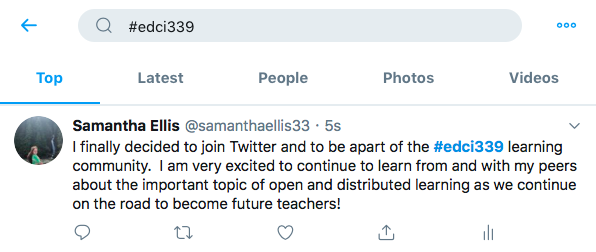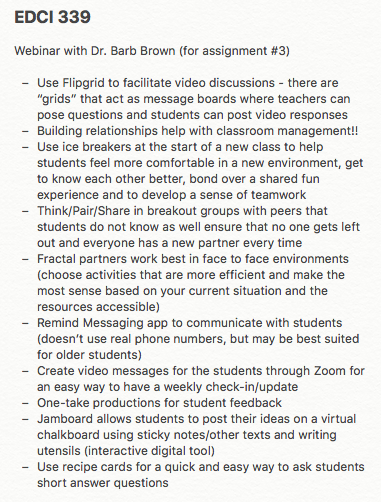The process of building relationships with students is extremely important as it can make the classroom environment feel like a safe space to learn, help students with their academic work and aid in classroom management. Jeffrey Martin (2019) argues that without the foundation of having built strong relationships in the classroom, “the engagement levels, respect, and trust of [the] students” (p. 2) as well as the likelihood of their success, would be severely reduced. I truly believe, as Rita Pierson states in her Ted Talk, “kids don’t learn from people they don’t like” (TED, 2013). In my experience, an effective way to strengthen relationships is with the mutual exchange of personal information so that people can connect over shared experiences, interests and opinions. When people share pieces of themselves with others, it builds trust and empathy between them. I always enjoy when a teacher shares information about their personal life and their past experiences because I find it easier to relate to them.
During a webinar with Dr. Barbara Brown, she advised us to use many great resources and applications such as Flipgrid (allows teachers to make grids to facilitate video discussions), Jamboard (allows students to post their own ideas on a board), recipe cards (great for asking questions) and Remind Messaging (do not have to use your own phone number to contact students) to assist in building relationships in an online learning environment. Although I think that while it is easier to build relationships in face to face and open learning contexts, it is definitely achievable in online learning contexts as well. When teaching in online learning contexts in my future teaching practice, I plan to use these tools as well as human-centered instruction (HCN) to assist in the development of relationships. HCN focuses on the combination of building empathy and “improving both the act of instruction and its outcome” (“What is Human-Centered Instruction,” n.d.). I also plan to use the Social Presence Model in order to develop a feeling of connectedness “among teachers and students for a more enriching educational experience” (Dikkers, Whiteside & Lewis, 2012, p. 22). The five aspects of the Social Presence Model are:
- Affective Association – how students and teachers show emotion online;
- Community Cohesion – seeing the class as a community;
- Instructor Involvement – how the teacher shows involvement in student learning;
- Interaction Intensity – what ways and how often students interact; and
- Knowledge and Experience – ways students share their prior knowledge and experiences with course content (Dikkers, 2018, p. 513)
I contacted a current grade 1 teacher to ask for her opinion on how she effectively builds relationships in online and open learning spaces. Amanda Ford, stated that “relationships are the first things that [she works] on when school starts, before [she] even [considers] doing anything to do with academics” (personal communication, July 21, 2020). In order to develop a sense of safety, belonging and community for her students in open and face to face learning spaces, Ford shares who she is as a person and as a teacher with her students, sends out surveys to the parents/guardians to understand what life is like outside of the classroom for her students, gives prompts for students to write about themselves, encourages the students to get to know each other through different activities (ex: “Find Someone Who…”) and co-creates the classroom rules and expectations with her students. Throughout the school year, she also ensures to complete emotional check-ins with the students, promote role-playing activities to help with productive problem solving, model how to appropriately interact with others and how to equitably divide group work with different peers in order to foster clear communication and interaction. While her experience with online learning spaces is more limited, Ford is planning on using several interactive digital tools in the future such as Microsoft Teams for “Get to Know You” activities, small group and class discussions and emotional check-ins throughout the year and Microsoft Forms to create and send out surveys to the parents/guardians and students as well as other activities. Videos will also be used to record a “Meet the Teacher” clip and her lessons so her students can have a more personal experience with their teacher through the opportunity to hear and see her. Ford’s goal is to provide her students with similar activities and strategies to the ones that she would normally use in open and face to face learning environments by modifying the activities in order to fit different digital tools/platforms.
Links to my other blog posts:
References
Dikkers, A. G. (2018) Social Interaction in K-12 Online Learning. In R. Ferdig & K. Kennedy (Eds.), Handbook of research on K-12 online and blended learning (pp. 509-522 ). Pittsburgh, PA: Carnegie Mellon University ETC Press.
Dikkers, A. G., Whiteside, A. & Lewis, S. (2012). Get Present; Build Community and Connectedness Online. Learning and Leading with Technology. 2 (22-25). Retrieved from: https://files.eric.ed.gov/fulltext/EJ991230.pdf
Martin, J. (2019). Building relationships and increasing engagement in the virtual classroom. The Journal of Educators Online, 16(1) doi:10.9743/jeo.2019.16.1.9
TED. (2013, May 3). Every kid needs a champion | Rita Pierson. [Video file]. Retrieved from https://www.youtube.com/watch?v=SFnMTHhKdkw&feature=youtu.be
What is Human-Cantered Instruction. (n.d.) Retrieved from https://www.leadsv.com/hcn








